13th and 14th of June, 2025. 6,5k and 8k in Sâo Tomé and Pantufo.
In Sâo Tomé, an island which closely resembles paradise, we woke up with the sun to run along the coast, passing by fishermen villages with their Portuguese colonial architecture while the boats were coming back to shore.
TLDR; “too long, didn’t read”
- I just want to run! Take me to RUN.
- I have 1 minute. Take me to USEFUL INFORMATION.
- Running is my excuse for travelling. Take me to TRIP.
- Running is my excuse for eating. Take me to CARBOLOADING.
- I want to know what to read in the plane. Take me to ONE BOOK.
🌍 The trip 📷: What to see in Sao Tome in a few days
🇸🇹 Visa for São Tomé & Príncipe 🛂
We started on the right foot, because, if you are European, you can visit São Tomé and Príncipe for tourism for a period of up to 15 days without a visa. Well done, Sao Tome’s government!
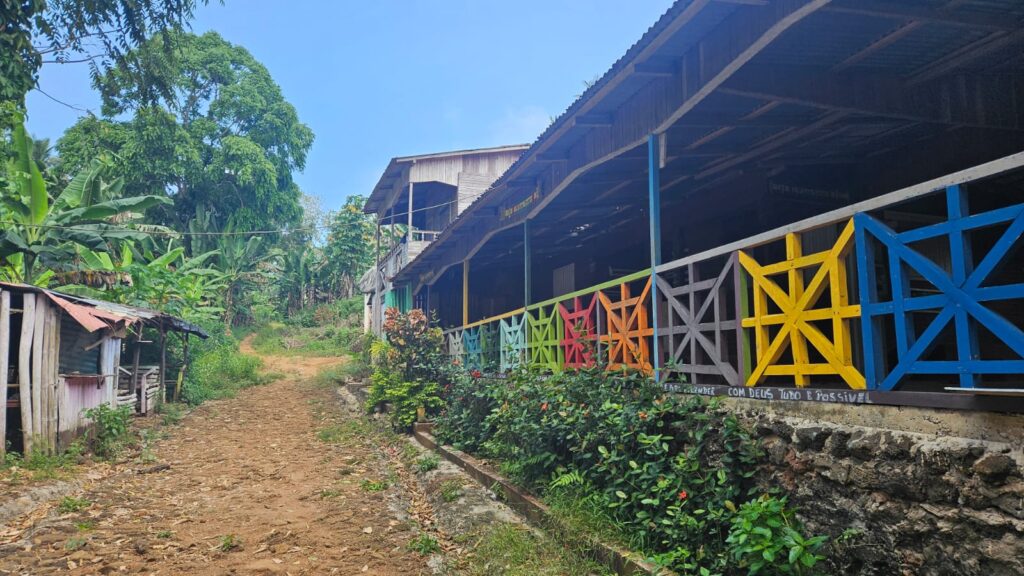
São Tomé and Príncipe is known for its laid-back pace of life, safety, and warm hospitality. And, indeed, we were soon going to learn about “leve leve”…
I also read that tourism was still relatively low, making it ideal for travelers seeking authenticity and tranquility without the tourist crowds common in other tropical destinations.
Plus, after a few weeks in continental Africa for our honeymoon, I wanted to finish the trip with a nice, quiet place with natural wonders.
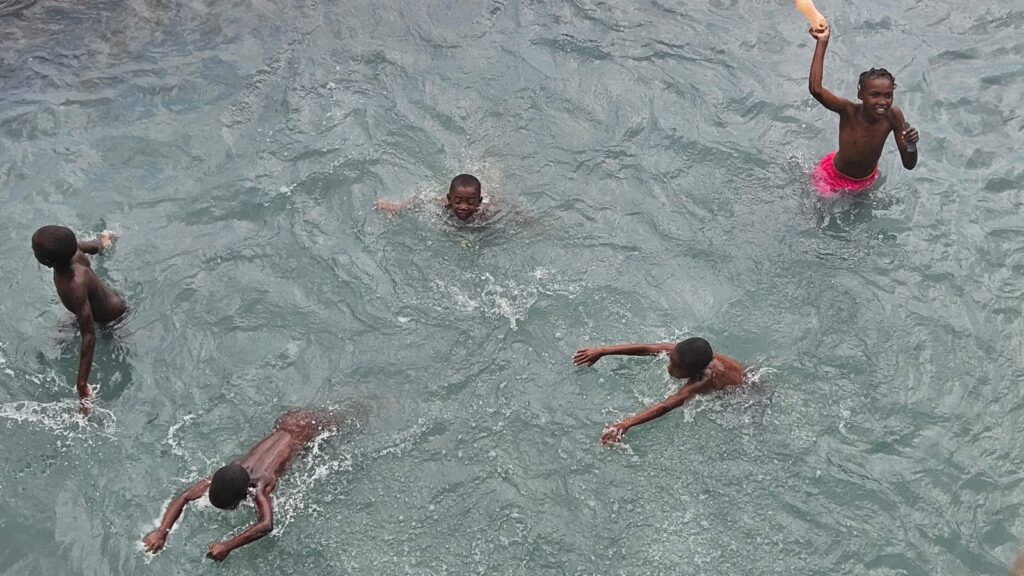
So, Sâo Tomé promised that.
São Tomé and Príncipe in a nutshell
São Tomé and Príncipe is a small island nation located in the Gulf of Guinea, off the western equatorial coast of Central Africa.
It is not an island: it ‘s several!

The two main ones are São Tomé and Príncipe, and then there are several smaller islets.
The country gained independence from Portugal in 1975 and remains one of the smallest and least populous nations in Africa.
Despite its size, São Tomé and Príncipe boasts a rich cultural heritage shaped by African and Portuguese influences (which we saw from Day 1, on our way from the airport), and its official language is Portuguese.
The islands are volcanic in origin and are characterized by lush rainforests, rugged mountains, and diverse wildlife.
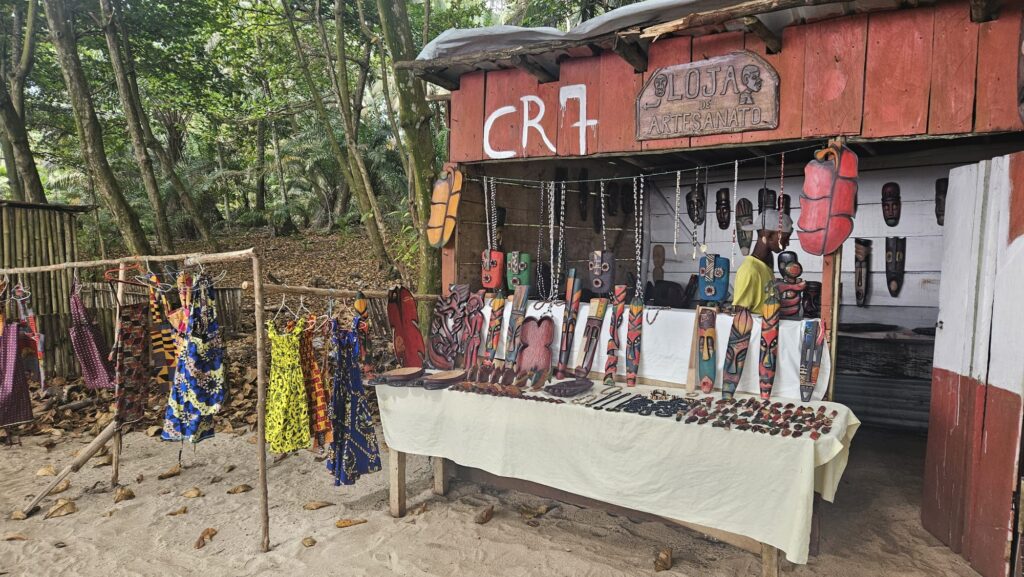
From all its attractions, I especially wanted to visit Rolas Island and see Pico Cão Grande.
Arriving: a road incident and a curious visit to a curious police station!
On the way from the airport to our boutique hotel, Emoyeni Gardens, our taxi, driven by a man named “Mr. Eduardo” was involved in a minor traffic accident.
On a narrow road, a small school bus didn’t stop and scratched the cab’s body. And then the bus didn’t stop either to check the damage.
But alas! Without further ado, “Mr. Eduardo” turned around furiously and began chasing the bus, driving at full speed along dark, unlit roads…
Bullit, Sâo Tomé Version
We were part of chase scene worth of an action movie 😣
Until he caught up with the bus! Then he got into a heated argument with the other driver while we sat inside the taxi, waiting…
The most surprising thing was that within seconds, and without knowing how, dozens and dozens of children in white uniforms appeared, shouting, laughing, and some of them telling us that “Sao Tome is good” with their thumbs up.
We realised later that there were two school buses, and they looked tiny but they could fit around 20 people.
Then, even more surprisingly, many police officers appeared. From where?
From the nearby airport police station.
A visit to the police station
A lot of shouting and arguing followed. Then, finally, two police officers got into our taxi and we drove to the police station.
Later, we realised and were told by our guide, Fernando, that arguing out loud is a favourite pastime here. The love it, and they don’t hold grudges. After a heated argument, people become best friends 😅
Anyway, we spent the next hour sitting down on a bench in the police station while they were “sorting out the issue”. The “affair”, they called it.
The police agents were very nice to us, and we talked with a big woman dressed in a flowery dress and wearing a wig who said her name was Sheila and she was also a police officer. She told us to be ‘calm’. We answered that we were, in fact, calm (because we were: just sitting there, relaxing, waiting for the incident to be over).
Curiously I also saw another woman carrying a small child on her back – this was truly “bring your kid to work”!
Everything was ok finally: Mr. Eduardo looked happier and we finally reached our hotel with another anecdote “in our bagpack”.
Rolas Island: Where the equator crosses the land… and almost meets the Greenwich meridian 😉🤣
The “Rolas Island” (Ilhéu das Rolas) is a small island off the southern coast of São Tomé and Príncipe, where the equator crosses the land. It’s a unique location due to this geographical feature and has a monument marking the intersection where you can stand with one foot in each hemisphere!

But, even more than that. There, the equator and the Greenwich Meridian nearly intersect! So the symbolic monument is marking one of the few places on Earth where both a zero-degree latitude and longitude crossing is so geographically proximate.
In fact, the striking equator monument was originally designed to mark the line of zero degrees latitude… and though the actual coordinates of the Equator-Greenwich intersection fall slightly offshore in the Gulf of Guinea, São Tomé’s monument offers a rare and powerful representation of Earth’s global reference system.
North meets south, east meets west.
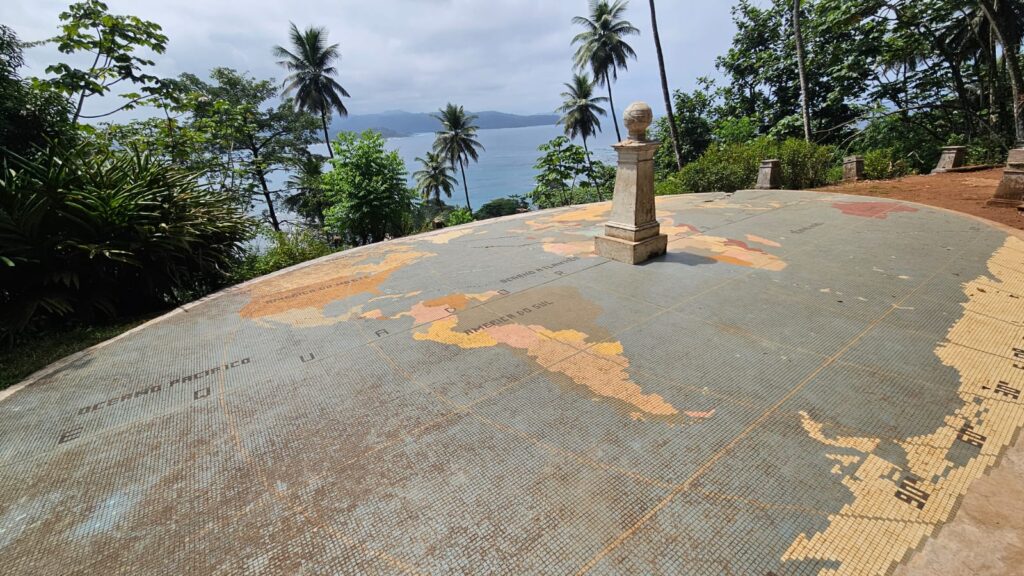
There were almost no tourists so we had plenty of time to admire the lush landscape and the monument, and of course we took numerous pictures and stood with each foot in each hemisphere!
The monument itself honors not only geography but also exploration. It is often associated with the legacy of Portuguese navigator Gago Coutinho, one of the pioneers of aerial navigation who played a significant role in charting air routes across the Atlantic.
His contributions to aviation and mapping are emblematic of the exploratory spirit that led to the discovery and colonization of the Gulf of Guinea islands by the Portuguese in the 15th century.
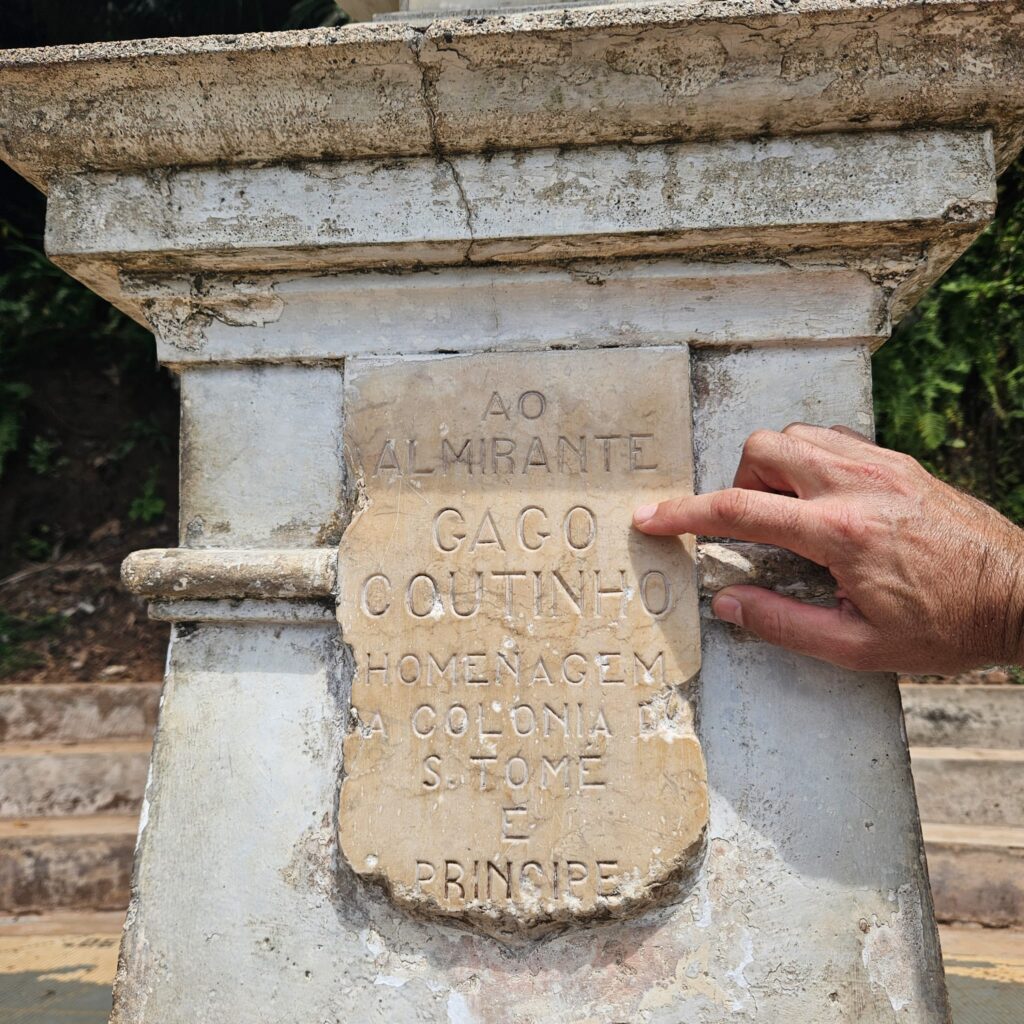
Today, the site serves as a geographic and cultural landmark, drawing travelers and geographers alike to witness the symbolic crossroads of the planet.
Cão Grande
Cão Grande, or Pico Cão Grande (“Great Dog Peak”), is one of São Tomé’s most iconic natural landmarks.
During our days on the island we had the opportunity to see it and were more impressed than seeing it in pictures.
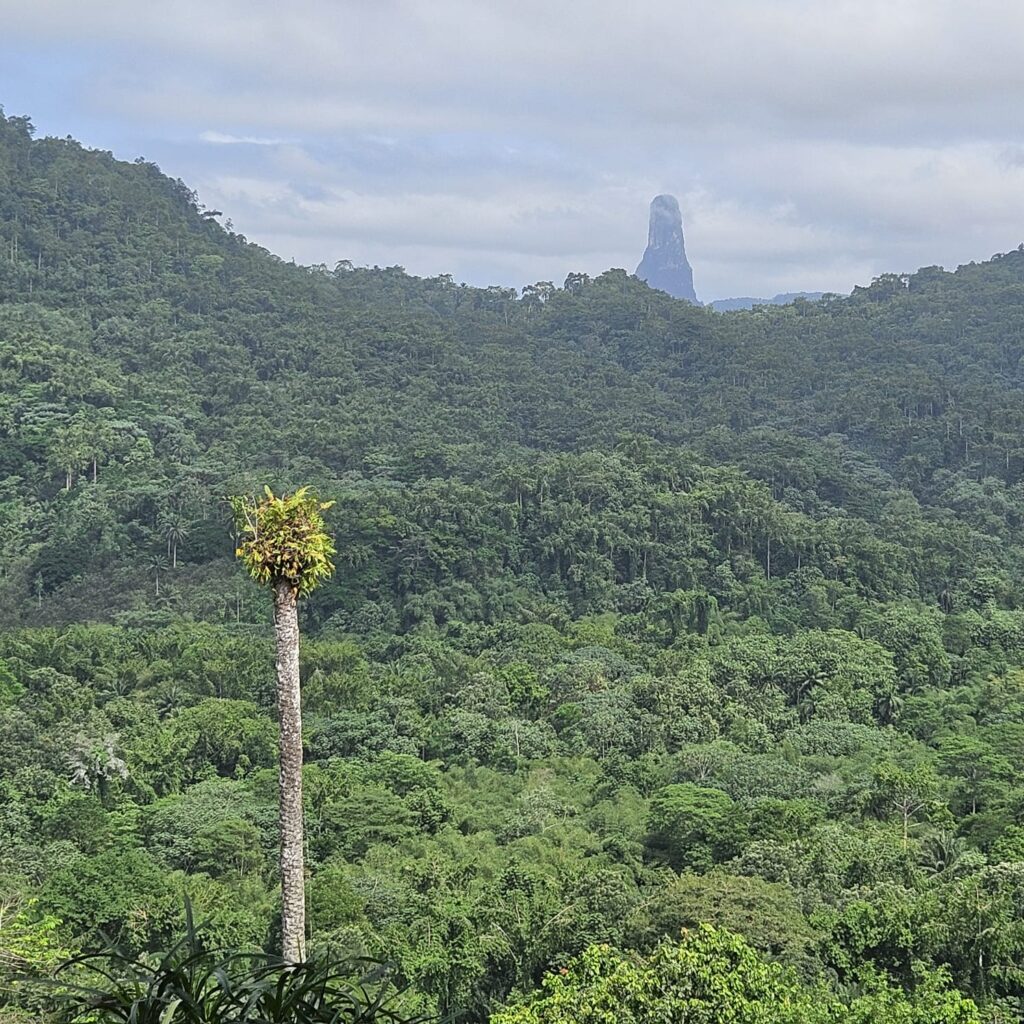
We did not reach its base, though, because it requires more than 4 hours hiking, but we got close enough to admire its dramatic, needle-like volcanic plug, that juts nearly 370 meters straight into the sky from the lush rainforest floor.
Located in the southern part of the island within Obô Natural Park, this towering monolith is the hardened core of an ancient volcano, exposed by millennia of erosion.
Shrouded in mist and often cloaked in clouds, Cão Grande appears almost otherworldly, attracting climbers, geologists, and photographers alike.
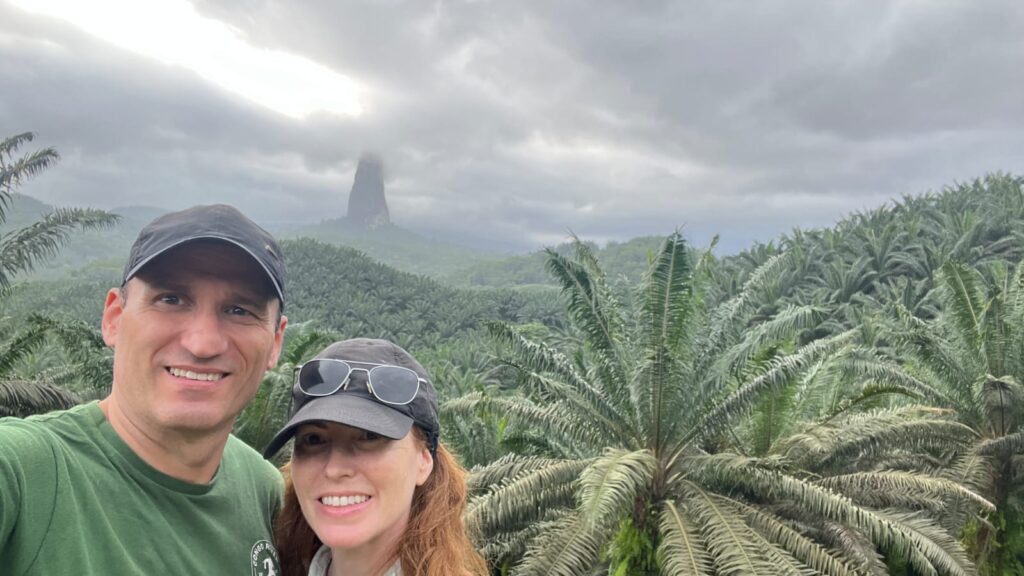
Its surrounding jungle teems with biodiversity, echoing the island’s unique blend of volcanic origin and equatorial rainforest, making the peak not just a visual marvel, but also a symbol of São Tomé’s wild, untamed beauty.
🌱 Plantations in São Tomé and Príncipe
I was also very interested in seeing the colonial-era plantations.
São Tomé and Príncipe became one of the world’s leading cocoa producers in the early 20th century, thanks to these vast colonial-era plantations (called roças).
These estates, established by the Portuguese during colonial rule, relied heavily on forced and contract labor, including workers brought from Angola, Cape Verde, and Mozambique.
Though São Tomé once earned the nickname “Chocolate Island,” its cocoa industry declined after independence in 1975 due to economic hardship and lack of investment.
Many plantations fell into disrepair. We saw that first-hand when we visited Agustin Netto and Diogo Vaz.
But the latter was still operating and later, when we visited the atelier shop of Diogo Vaz in Sao Tome, it showed us that a few of them are being revitalized with a focus on sustainable and high-quality chocolate production, helping rebrand the islands as a premium cocoa source.
🍫 Diogo Vaz
Diogo Vaz is a historic cocoa plantation on São Tomé Island that has been transformed into a model of organic, bean-to-bar chocolate production.
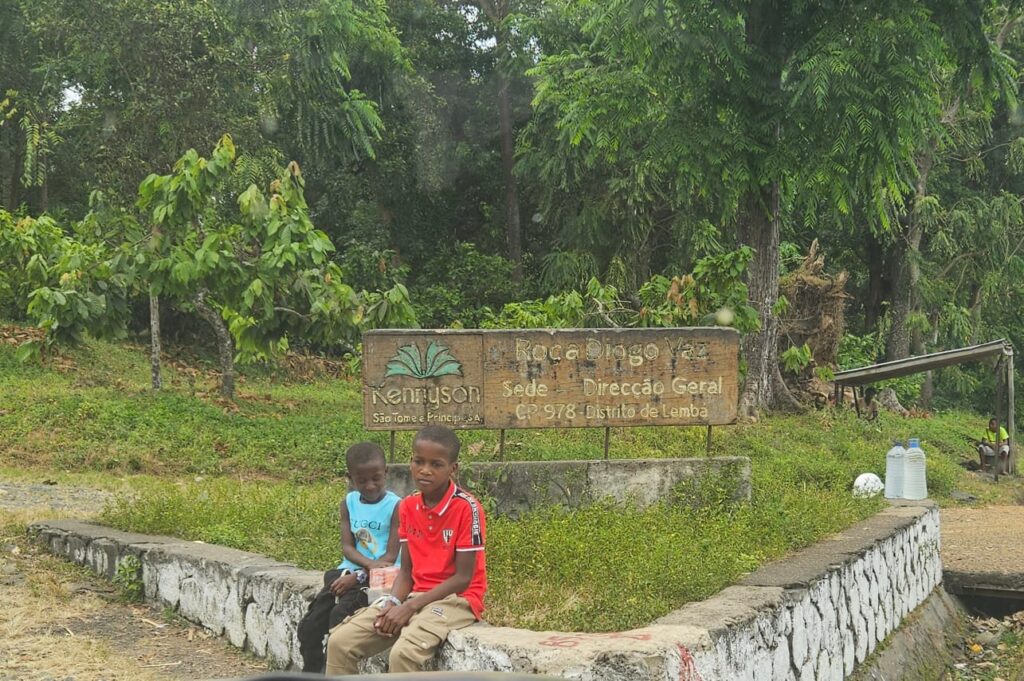
Originally a colonial plantation, it was abandoned post-independence and later revived by a French-Santomean team.
Today, it produces high-end chocolate using agroforestry techniques and fair labor practices, combining tradition with innovation.
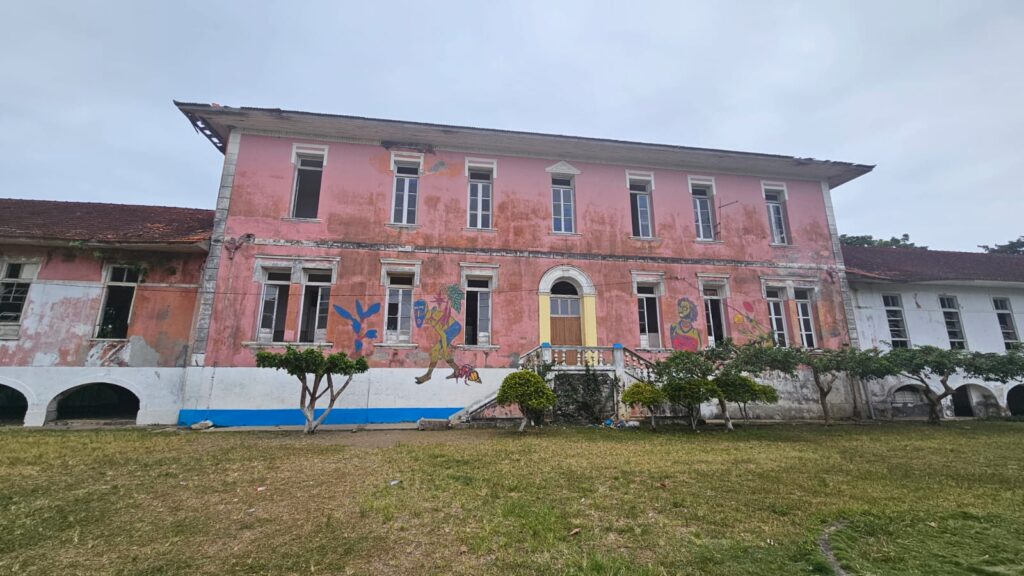
The estate controls the entire process—from growing and fermenting the beans to crafting the final chocolate—earning international acclaim for its ethical sourcing and exceptional quality. Diogo Vaz is a symbol of how São Tomé is reclaiming its cocoa legacy through sustainability and craftsmanship.
🌿 Agostinho Neto Plantation (Formerly Roça Rio do Ouro)
The Agostinho Neto plantation, originally called Roça Rio do Ouro, is one of the largest and most iconic former plantations (roças) on the island of São Tomé, in the district of Lobata.
It was founded in 1865 by Gabriel Bustamante and later owned by the powerful Marquis of Vale Flor, a major Portuguese colonial figure.
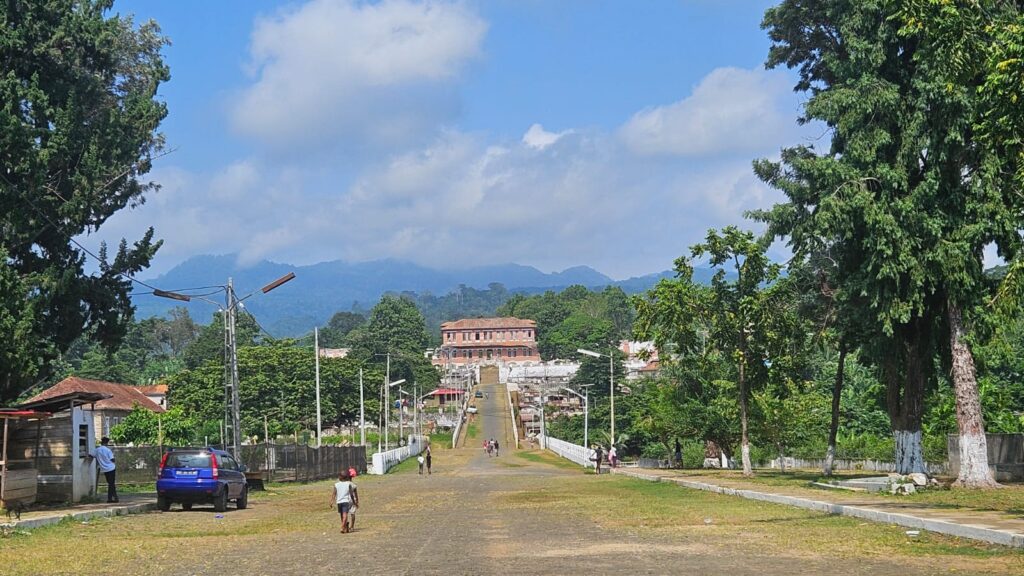
During its peak in the early 20th century, it covered around 5,000 hectares and featured some of the most advanced plantation infrastructure in the region: a hospital, maternity ward, chapels, workers’ quarters (sanzalas), workshops, a power station, and even a private railway that once stretched over 200 km of track.
After São Tomé and Príncipe gained independence from Portugal in 1975, the plantation was renamed Agostinho Neto in 1979 to honor the first president of independent Angola, a prominent anti-colonial leader. However, the departure of colonial administrators and economic decline led to widespread abandonment and decay.
And now?
Many of the grand buildings, including the hospital built in the 1920s, have since fallen into ruin, with parts collapsing as recently as 2014.
When we visited it offered a decadent yet fascinating sight. The site is a haunting but powerful symbol of colonial history.
Roughly 1,300 people, many descendants of Angolan, Cape Verdean, and Mozambican workers brought during the colonial period, still live within the remains of the estate.
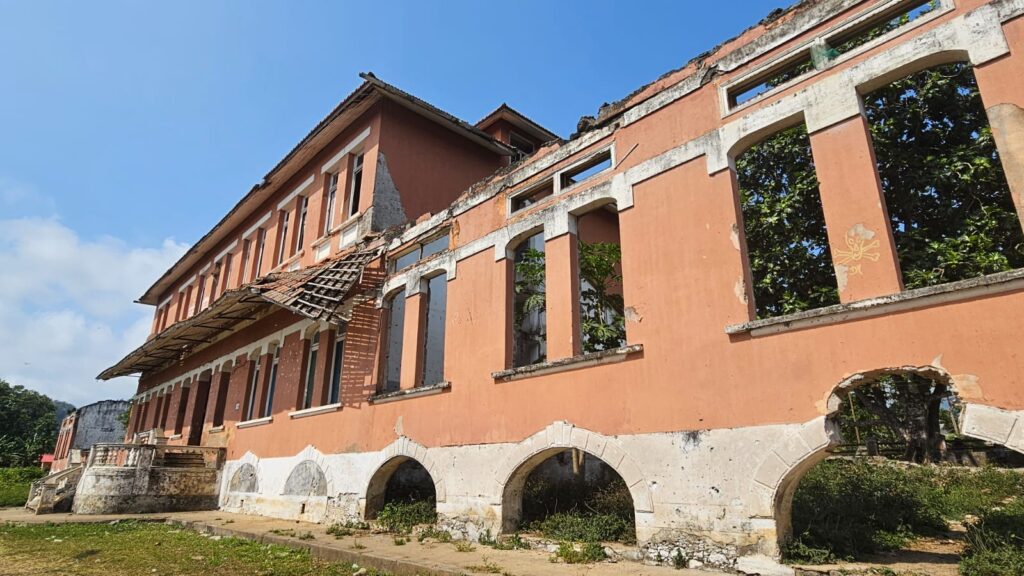
Life is difficult, and conditions are precarious, but the site remains alive as a living heritage landscape. We saw colourful clothes drying everywhere, old parabolic antennas, kids shouting, smiling and saying “Hola hola hola! Bom dia!” and beautiful girls with decorated braids with beads and hair cuffs made of plastic or metal that are attached to the ends or threaded through the braids.
And, apparently, there have been discussions and efforts to preserve and repurpose the roça as a historical and cultural tourism site, owing to its striking architecture and deep socio-political significance.
🏃♀️ The Runs 🏃♂️
Getting ready
After doing research, we were confident that running in Sâo Tomé was not going to be dangerous.
Even so, the previous night we asked the hotel manager if it was safe, to which she obviously said yes, but she told us to run very early to avoid the sun. She also mentioned the holes in the pavement.
So we looked up the sunrise time online: 5:28am; and then set the alarm clock to that hour.
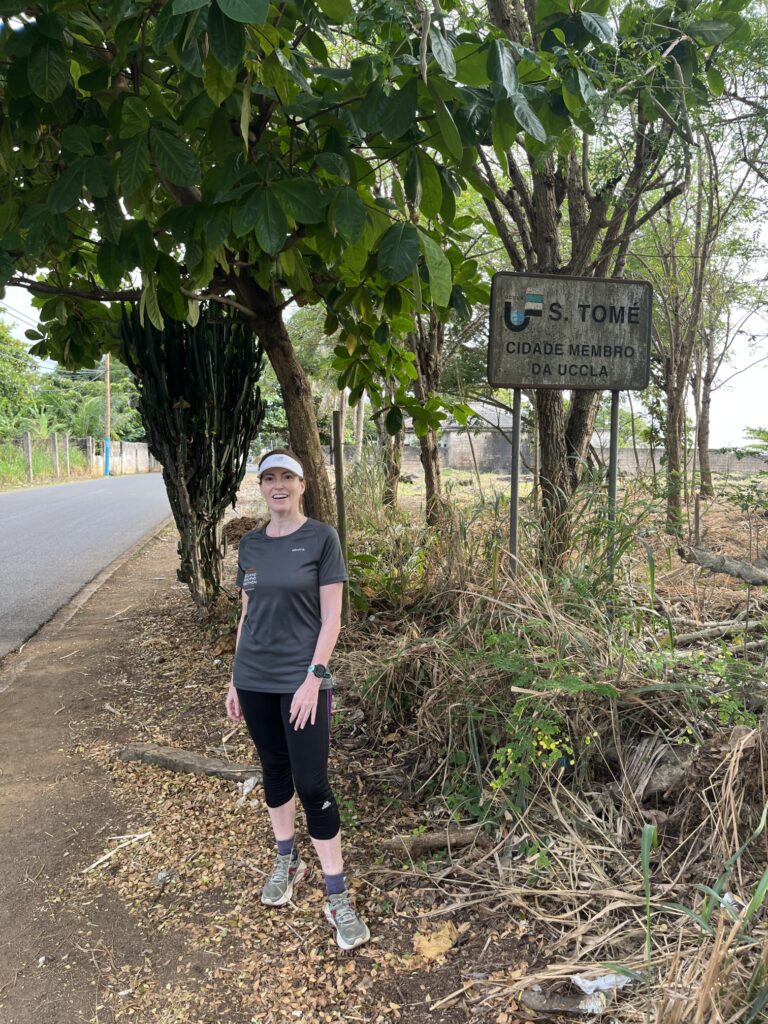
We woke up with the sun.
I did put on suncream, as precaution, although the sun was not strong by the time we finished our run.
Run logistics
The route has not much elevation, although it can get a little bit hilly if you continue South.
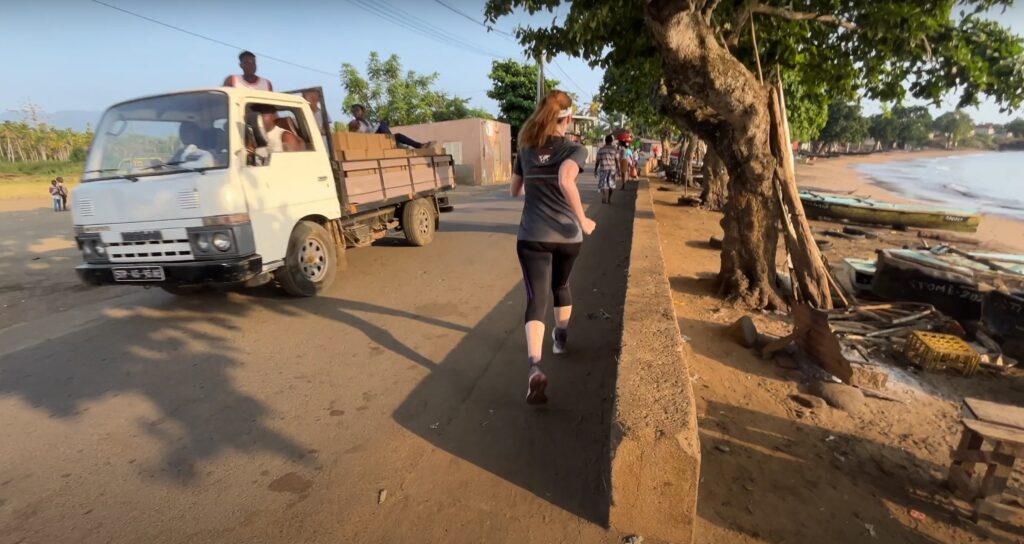
We faced only a minor hill from kilometer 2,5 to approximately kilometer 3.
You can shorten the route or lengthen it, as you wish, following the coast.
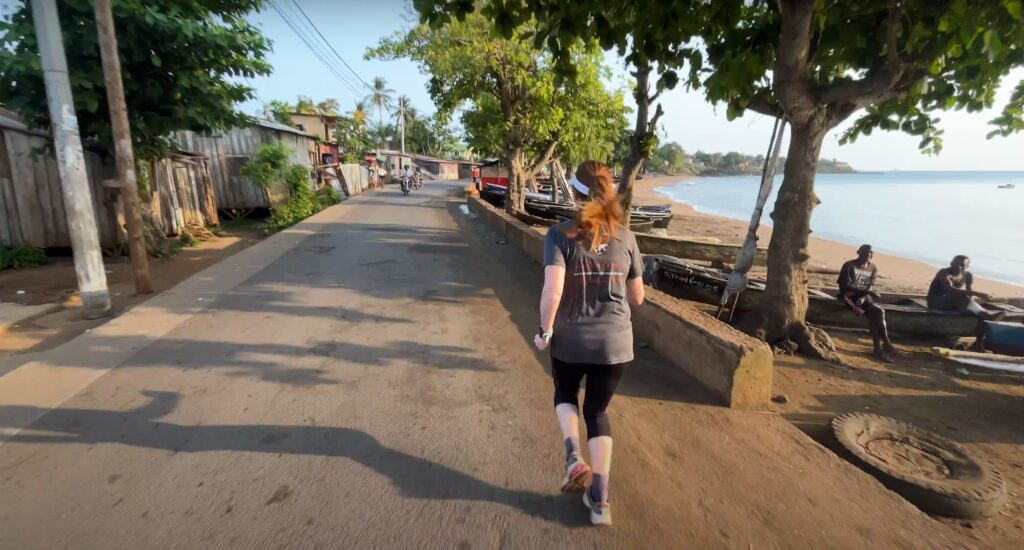
Curiously enough, there were water fountains! Everywhere! Not all of them worked, but a few did. Later that day, we would see gatherings of women filling up bottles and buckets at the ones which were working.
The traffic
Since we left our hotel before 6am, at that time the roads were still not crowded, which was good. Later, the roads got very busy and the pollution became very annoying.
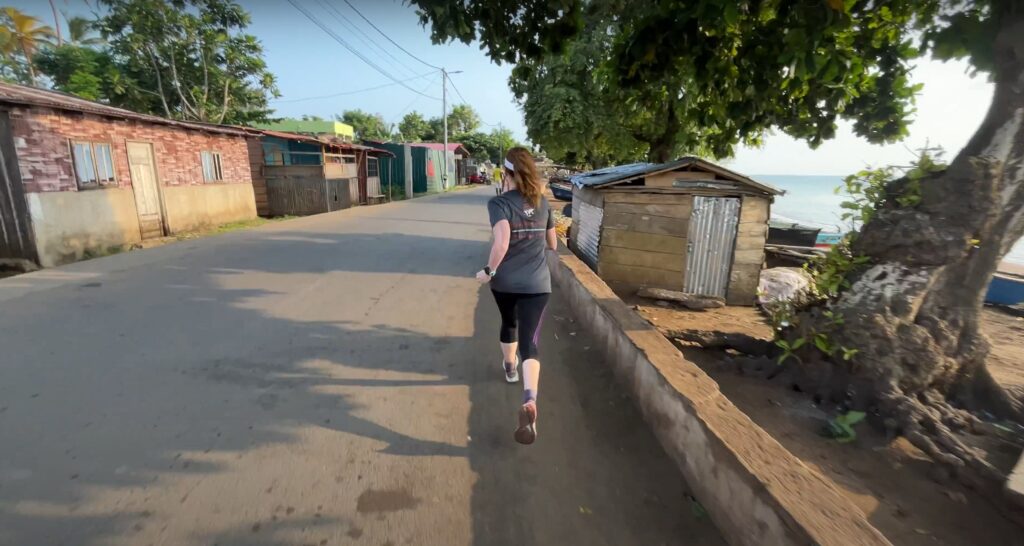
The country has a problem with the exhausts!
It seemed that the carburetors in most vehicles didn’t work very well, because they emitted a lot of carbon dioxide!
Another thing to watch out for were the motorbikes. They passed by quite closely. Although some did horn to warn us. This is very usual here, and it is not a sign to protest, but a kind gesture 🤨
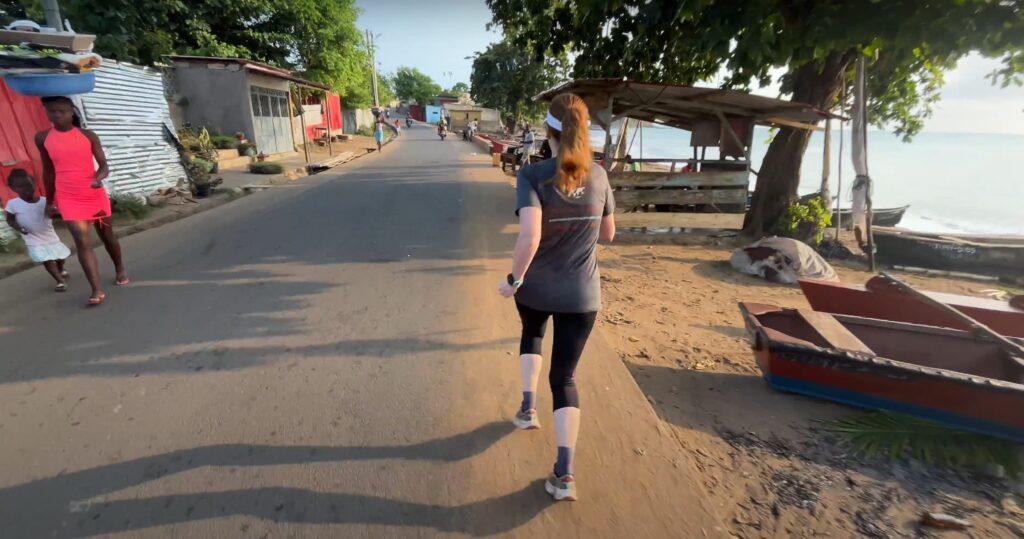
The road
It was easy to run. The road was wide and flat. In many places, the terrain was alsphalt (so, even) and covered by a layer of sand (so, softer) 👍
However, as we’d been warned, we had to watch out for potholes and holes in the pavement.
Leaving São Tomé, a few meters away from our hotel, we passed by the City Hall, the “Palácio dos Congressos”.
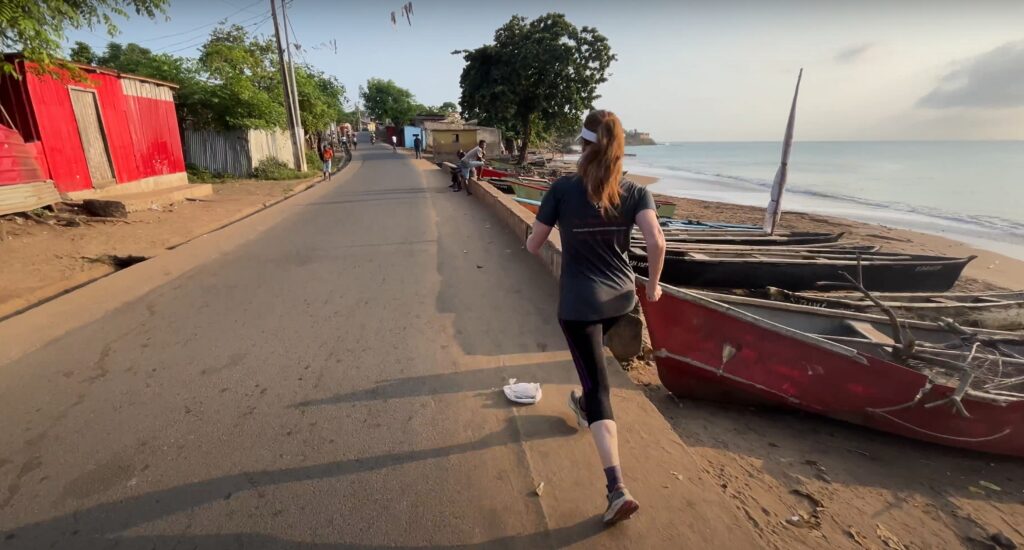
That area of the coast was fenced off because they were doing work to repair the seafront in preparation for the independence celebrations, which were going to be in a month:
Independence Day in São Tomé and Príncipe is celebrated annually on July 12th, commemorating the country’s full sovereignty from Portuguese colonial rule in 1979. This public holiday is marked with parades, cultural performances, and traditional dances.
The coast
The coast is typically volcanic and has strong waves. In fact there are some surf clubs in Sao Tomé, although the coast is too rocky and therefore, dangerous.
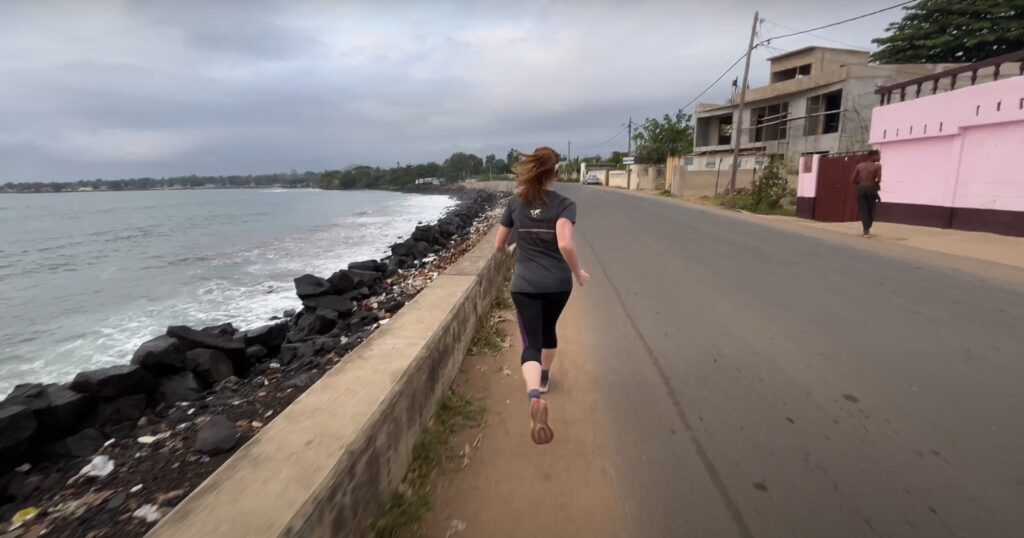
Little kids waved at us and said “Hola, hola! Bom dia”.
There were also a lot of stray dogs, but they were very peaceful. They didn’t even bark at us!
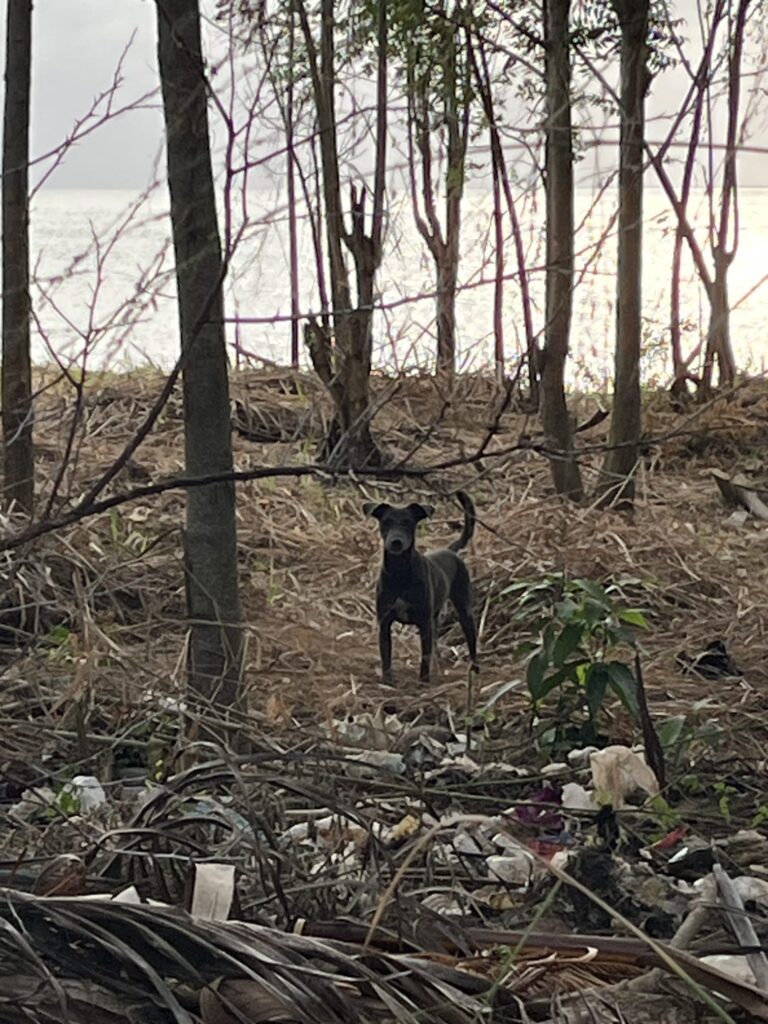
After a stretch of coast with dark rocks we approached the town of Pantufo and everything became colourful. The colours of the fishing boats, of the stone verandas (everywhere), the houses or even the church.
Sâo Tomé’s Giant’s Causeway
Then we arrived at a place that looked like Giant’s Causeway!
Unfortunately there was also a lot of plastic garbage near the shores, but it wasn’t enough so as to make the place lose its charm.
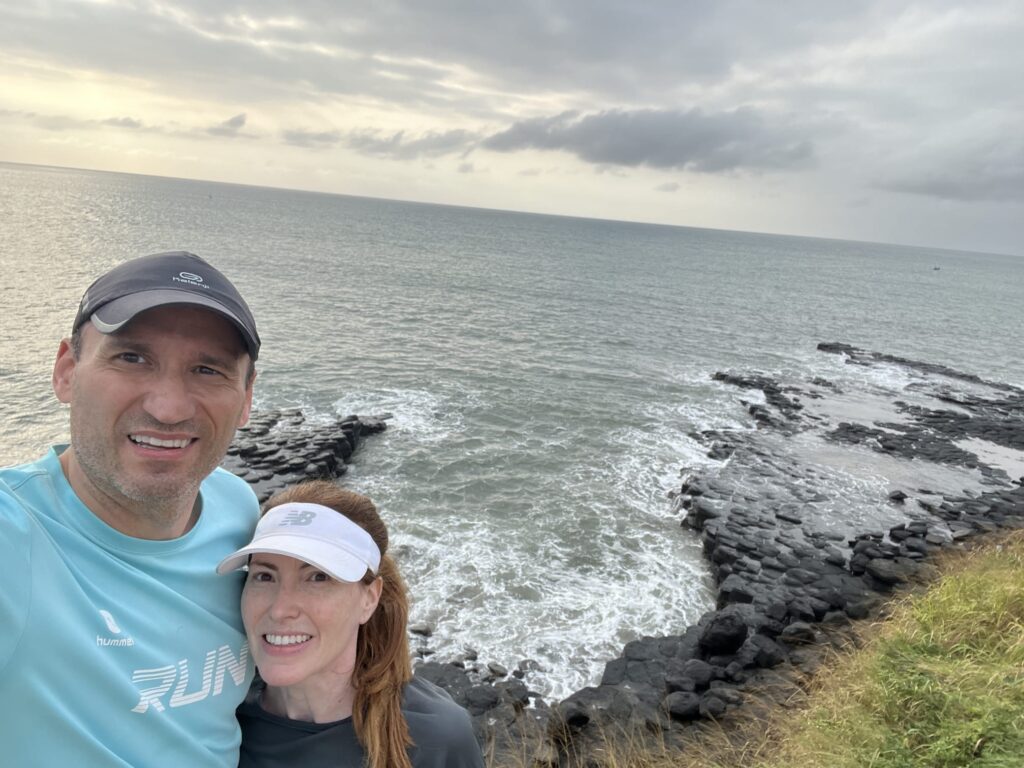
Abandoned vehicles
Another surprising thing was the quantity of abandoned vehicles 😆 Some of them looked like a mechanical Angkor Wat, with lush vegetation conquering their skeleton!
After kilometer 3,2 we turned around and we enjoyed our way back as much!
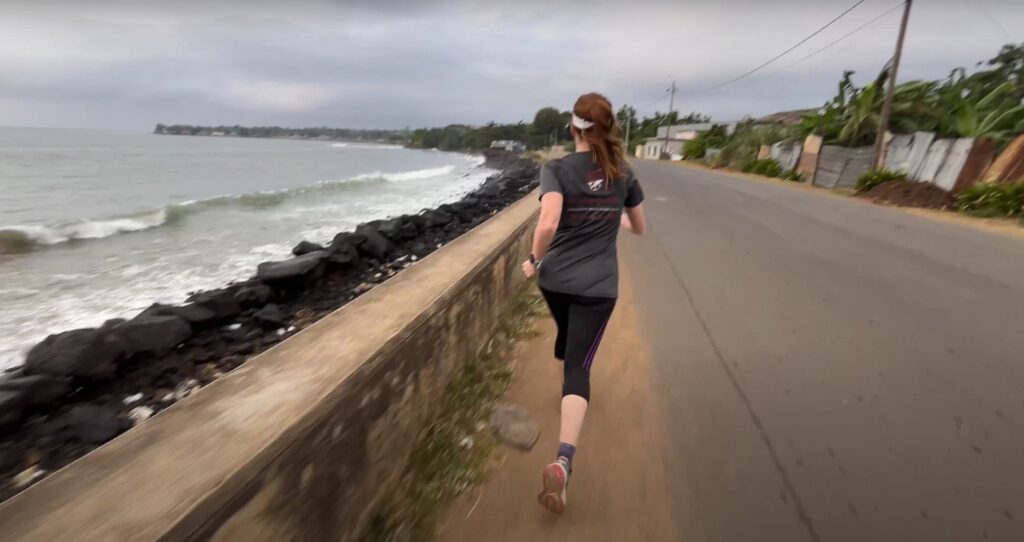
We stopped to take a picture of the local church, the Igreja de São Pedro, a small but significant Catholic church dedicated to Saint Peter.
Igreja Sâo Pedro
It was built in Portuguese colonial style, it features a modest bell tower, elegant façade, and a prominent decoration above the entrance showcasing Saint Peter’s three keys—a symbol deeply rooted in local religious tradition and reflective of his role as the gatekeeper of the Church.
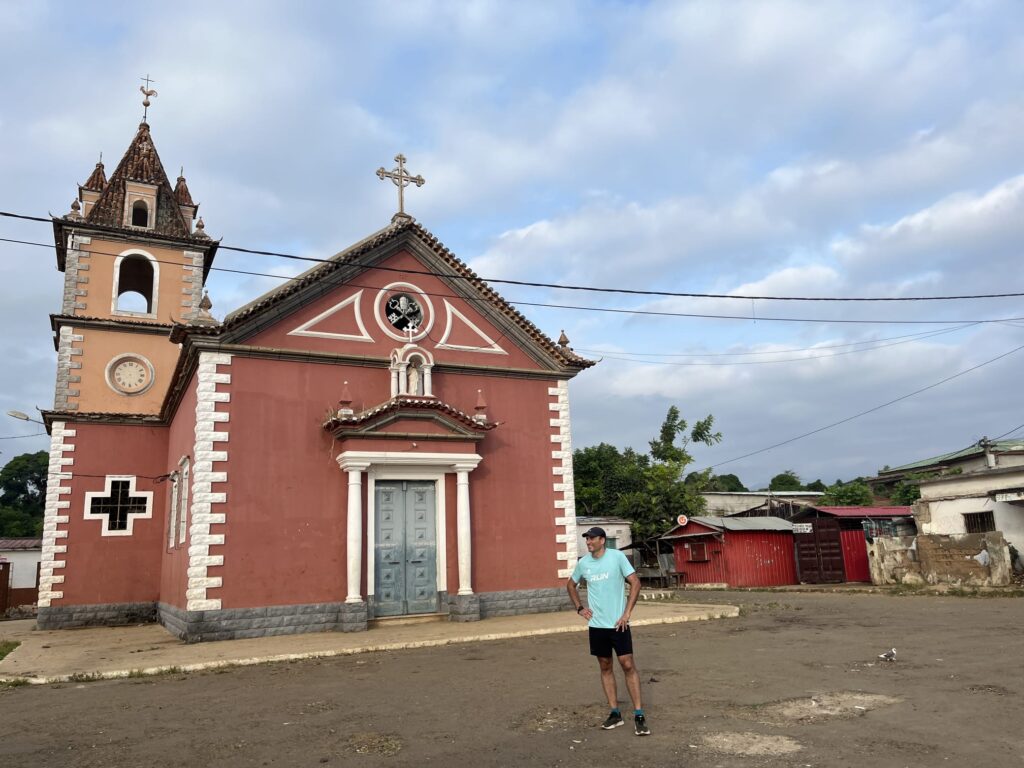
This iconography echoes in the name of the village itself: in local lore, Saint Peter is the patron saint of the fishermen, blessing the boats and anchoring the community’s faith and maritime identity.
And around the church, life was unfolding in front of our eyes. There were still a lot of kids waving at us while saying “Hola! Hola!”.
The usual sights
Women were carrying baskets of wet clothes to dry on their heads. Typically African style!
Later that day, we would see colourful clothes left to dry in the sun everywhere!
Many youngsters were wearing basketball sleeveless tops. Surprisingly, I saw many Michael Jordan ones, Chicago Bulls’ with number 23.
Who would have thought he was still trendy in 2025? 🤔
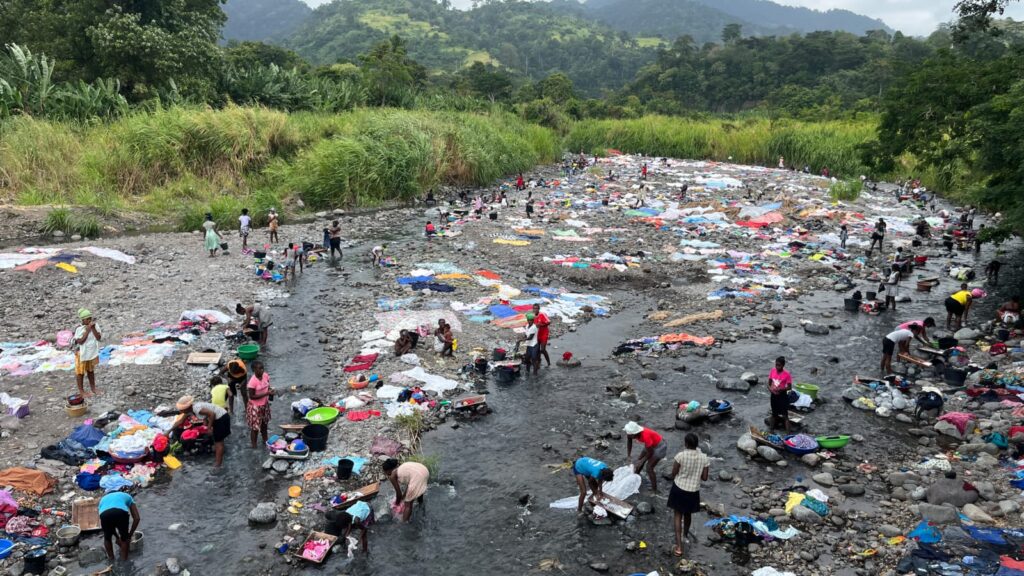
We saw also a few cards abandoned on the ground, and I took one one, the 3 of Hearts: I liked it as 3 is my lucky number 🥰.
🏃♀️ Second Run🏃♂️
Since we had enjoyed our run so much, the following day we ran it again, but for 2 kilometers more.
We ran until the next fishermen village, Praia Melao, which was equally colourful, and back.
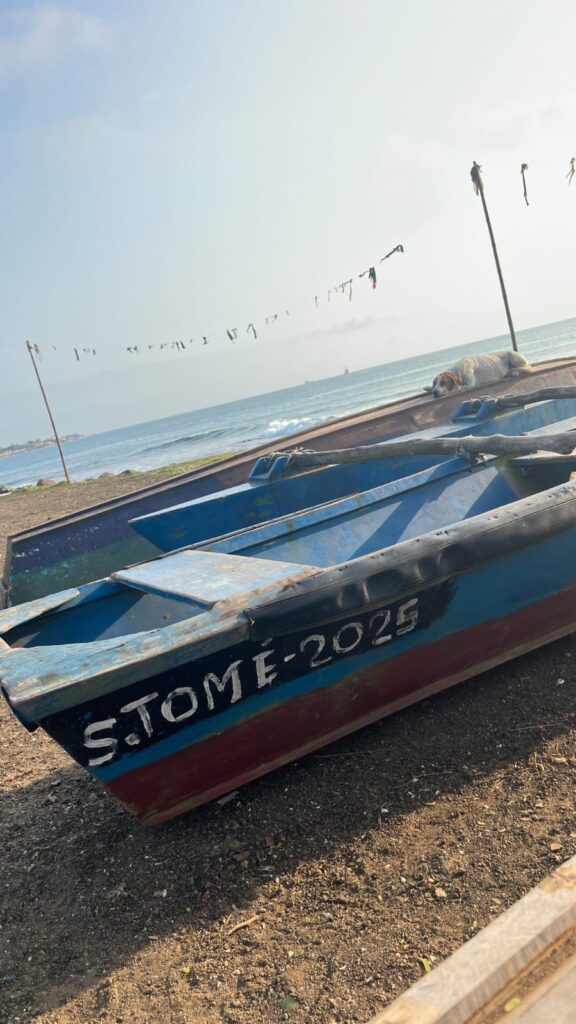
That day it was slightly more sunny and the temperature slightly warmer.
But, still, at 6am, there was no need to carry water and it wasn’t hot enough to make it difficult.
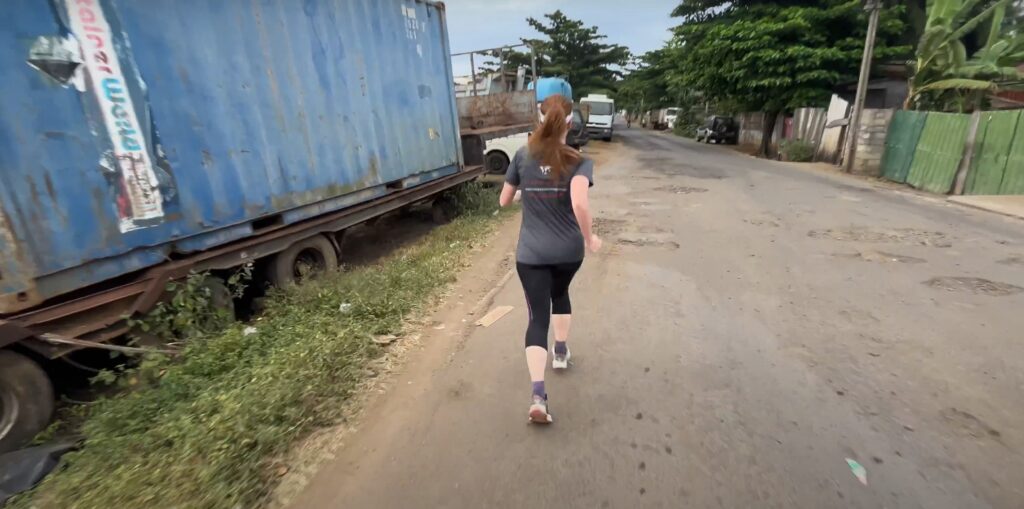
The second run gave me the opportunity to enjoy the surroundings more and pay attention to details.
A very local Marketing technique
Like a shop beautifully painted with the items sold: octopus or “Vino tinto”:
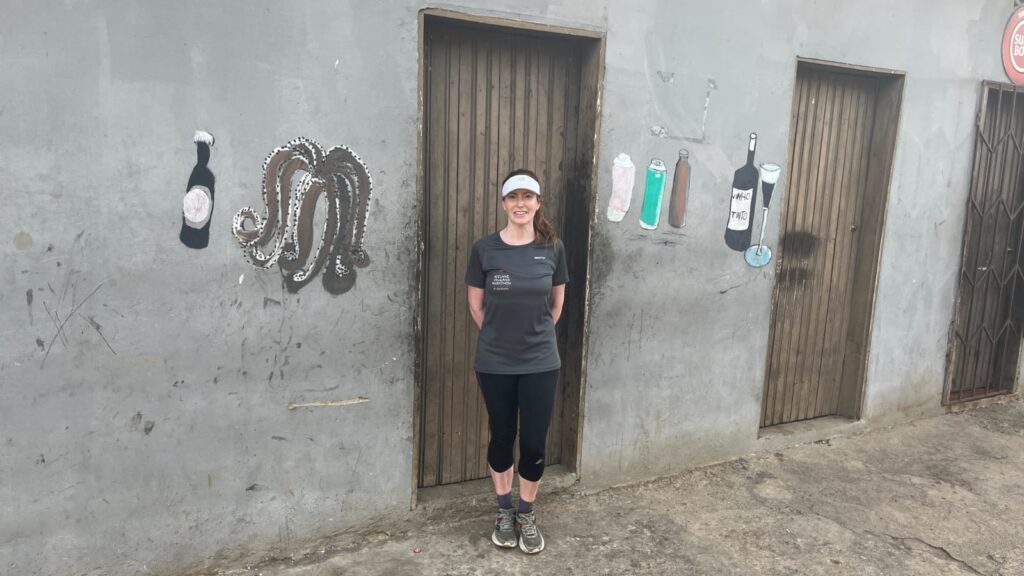
We also stopped to take a few pictures on the beach, amongst the boats.
The colourful boats were all labelled “Sao Tomé 2025”. Dogs were lazily resting on top of them… as if they, too, had finished a hard day’s work.
An old guy was walking slowly dressed in a rugged t-shirt sporting the following slogan:
“Gute Leute, Gute Arbeit, Gute Geld“. God knows where he got it 😂
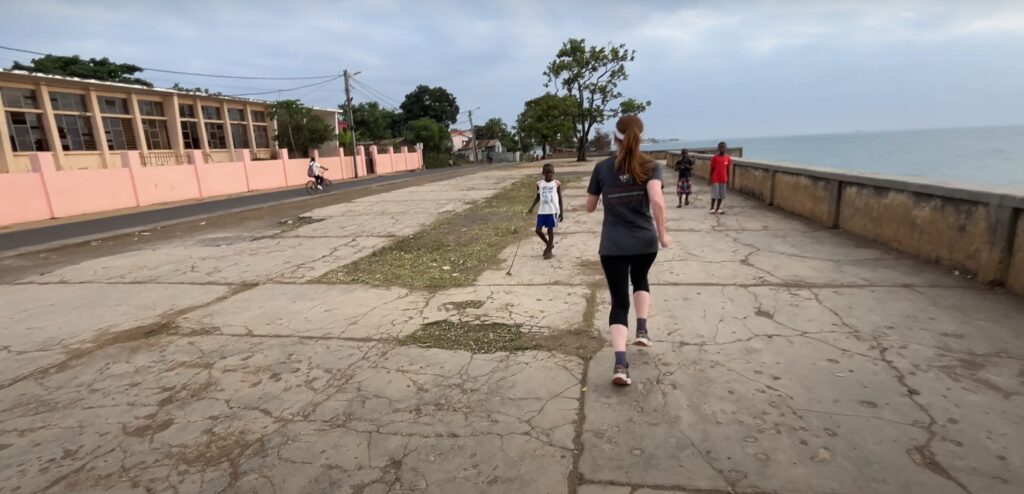
It was a good run, perfect to start our second day exploring the island.
Relaxing afterwards…
And, after our run, a bath in the cozy swimming pool of Emoyeni Gardens!

🍜 Carboloading 🍝: What to eat in Sao Tome if you are a runner
São Tomé and Príncipe has a rich culinary tradition influenced by Portuguese, African, and Creole flavors. If you’re looking for high-carb dishes to fuel up before a run and high-protein meals for post-run recovery, here are some great options:
🍌 3 High-Carb São Toméan Dishes (Pre-Run Fuel)
These meals provide sustained energy for endurance.
1️⃣ Funge de Banana 🍌
- A smooth, mashed dish made from green bananas or plantains, often served as a side with fish or meat.
- 🔥 Why it’s good for running? Bananas are rich in carbs and potassium, helping with energy and preventing muscle cramps.
2️⃣ Arroz Doce (Sweet Rice) 🍚🍯
- A creamy rice pudding cooked with coconut milk, sugar, and sometimes cinnamon or vanilla.
- 🔥 Why it’s good for running? The quick-digesting carbohydrates provide a fast energy boost.
3️⃣ Cocada Amarela (Yellow Coconut Pudding) 🥥🍳
- Made with coconut, sugar, eggs, and flour, this dessert-like dish is high in energy and fats.
- 🔥 Why it’s good for running? The combination of carbs and healthy fats ensures long-lasting energy for endurance sports.
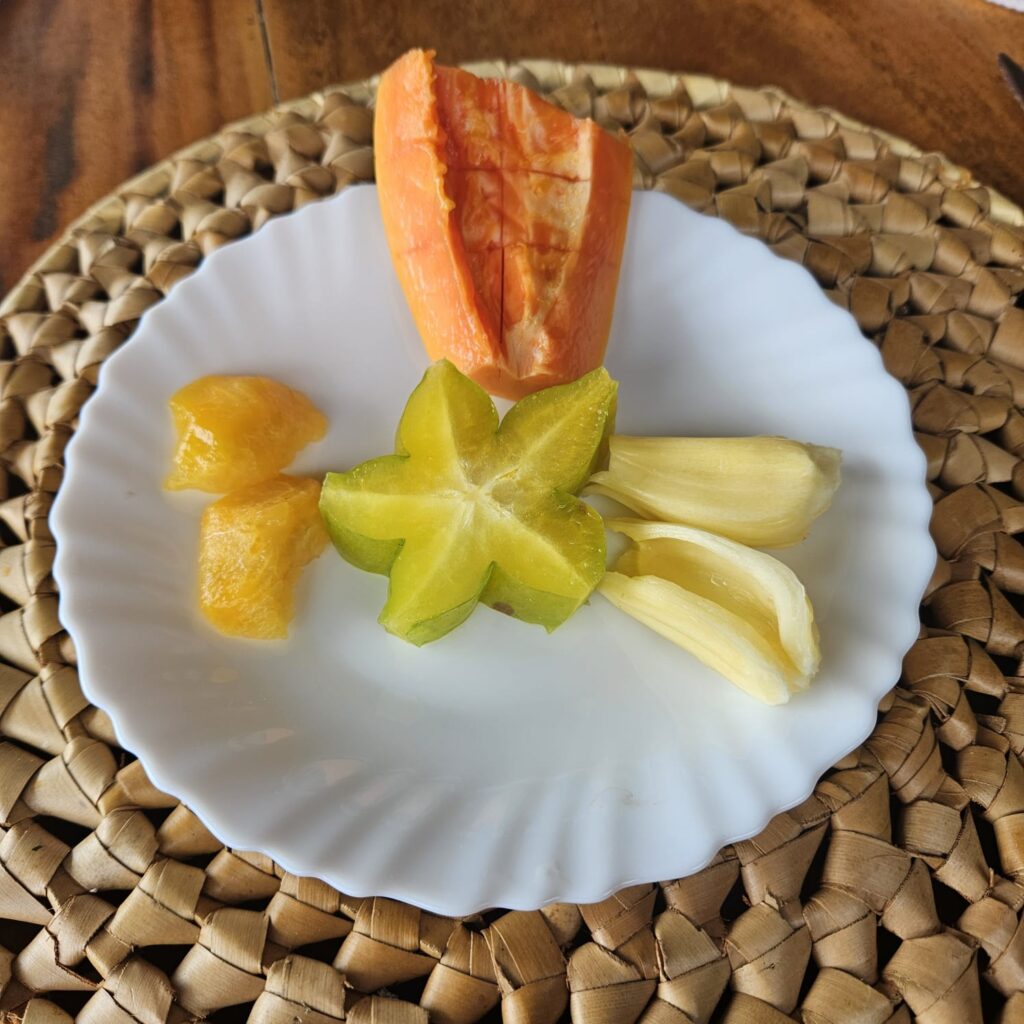
🐟 3 High-Protein São Toméan Dishes (Post-Run Recovery)
These meals help rebuild muscles and promote recovery.
1️⃣ Calulu de Peixe (Fish Stew) 🐟🍲
- A traditional dish made with smoked fish, palm oil, okra, and spices, often served with rice or funge.
- 💪 Why it’s good for recovery? Fish is a great source of lean protein and omega-3s, which help reduce muscle inflammation.
2️⃣ Feijão con Óssame (Beans with Meat) 🫘🥩
- A protein-packed stew made with kidney beans, pork, or beef, often flavored with garlic and bay leaves.
- 💪 Why it’s good for recovery? Beans provide plant-based protein and fiber, while meat adds essential amino acids for muscle repair.
3️⃣ Frango Grelhado com Jaca (Grilled Chicken with Jackfruit Sauce) 🍗🌿
- A dish featuring grilled chicken served with a sweet and savory jackfruit sauce.
- 💪 Why it’s good for recovery? Chicken is high in lean protein, and jackfruit contains vitamins and antioxidants that help with post-exercise recovery.
Simple but good food: Grilled Fish on the Beach.
In Rolas Island we enjoyed grilled red fish which was delicious, grilled and seasoned with species and coconut oil.
And fried bread fruit, which was also so tasty!
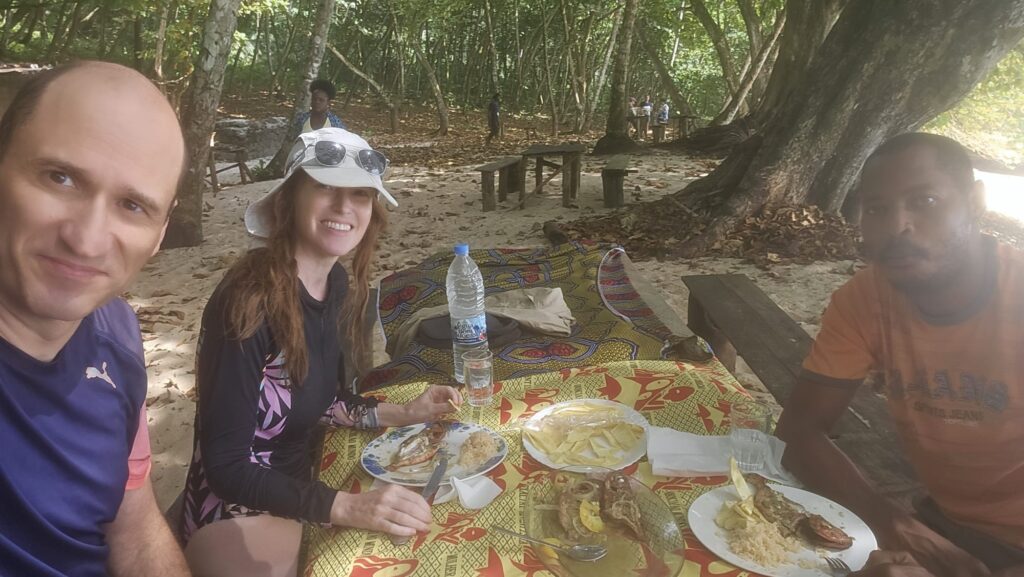
I think I could get addicted to fried bread fruit: the local “Pringles” treat 😀
A restaurant with a gastronomic menu!
In Morro Peixe, near Tamarind Beach, MonteMar restaurant offered us a tasting menu, totally organic (obviously), and that was excellent.
Really good indeed.
The menu consisted of two entries, one main and one desert:
Sweet potato pure and octopus salad with fried banana as entries.
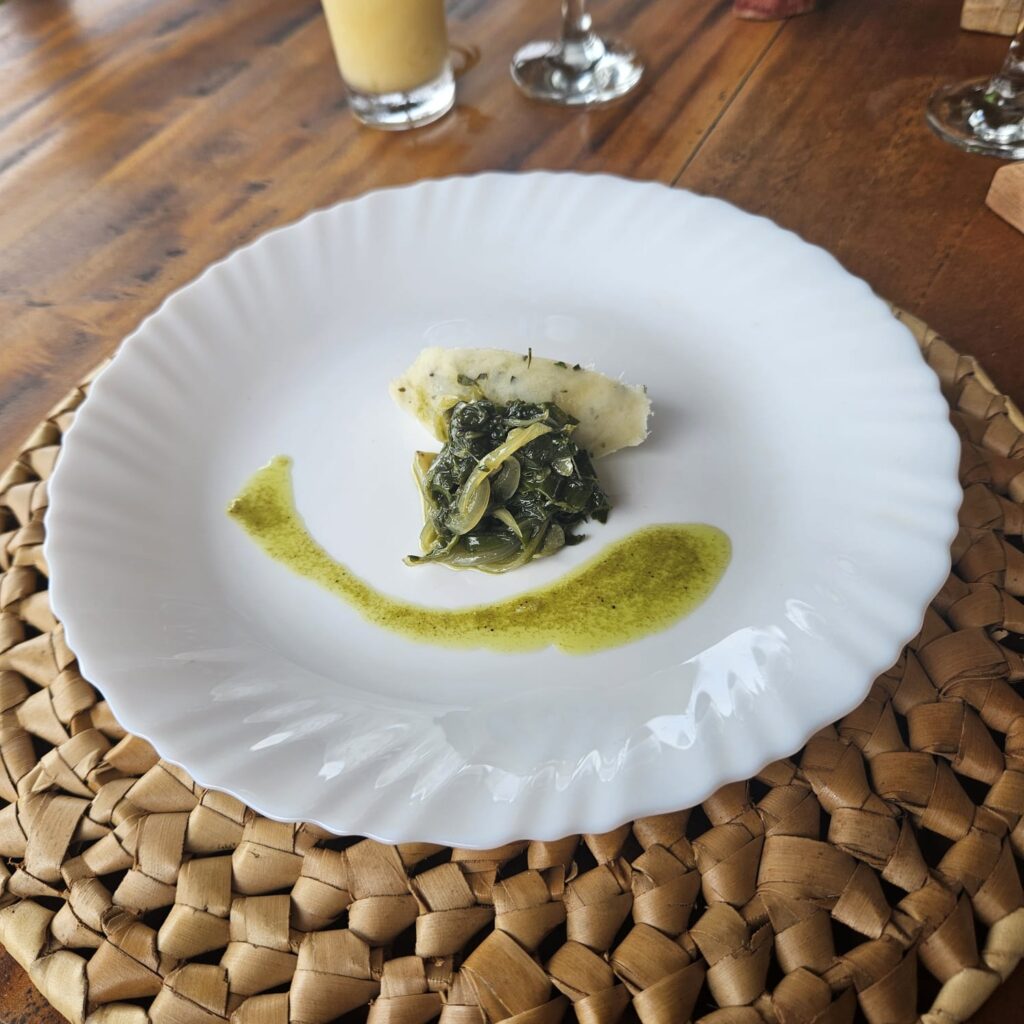
Octopus stew with “rancho” (Rice with beans) as the main dish, and a variety of fruits as dessert.
I really recommend it. I also had a cajá-mango juice with a touch of ginger, very local.
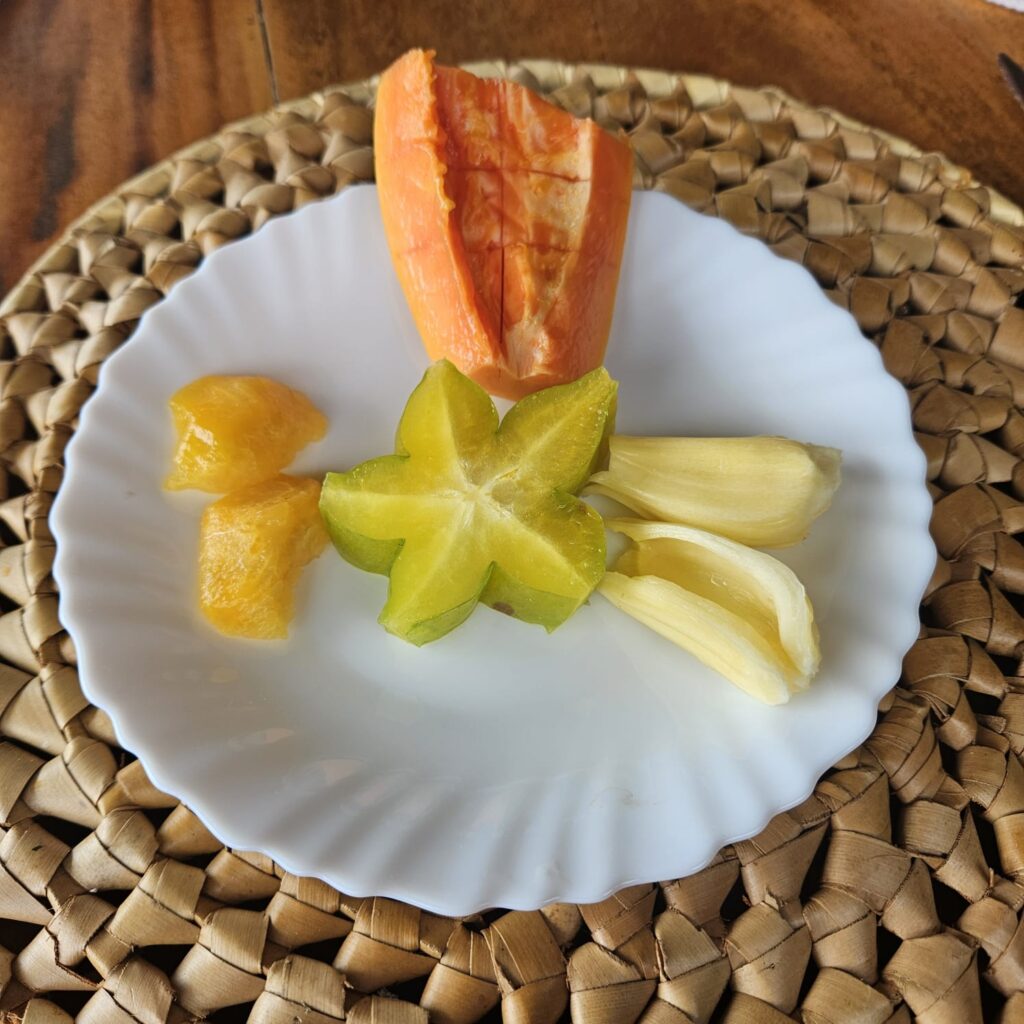
The whole menu was 15 EUR per person, making it very good in terms of value for money.

Useful information
🏃 Run along the coast in the island of Sâo Tomé. From the main city, Sâo Tomé, to Pantufo and / or Praia Melao.
👟 Urban: bring shoes for asphalt.
✅ A wide enough road with scenic views and very colourful images.
✅ A route not too hilly that you can shorten or lengthen as you wish.
⚠️ Suitable for early hours, as later the temperature is high and the traffic, very chaotic.

Map

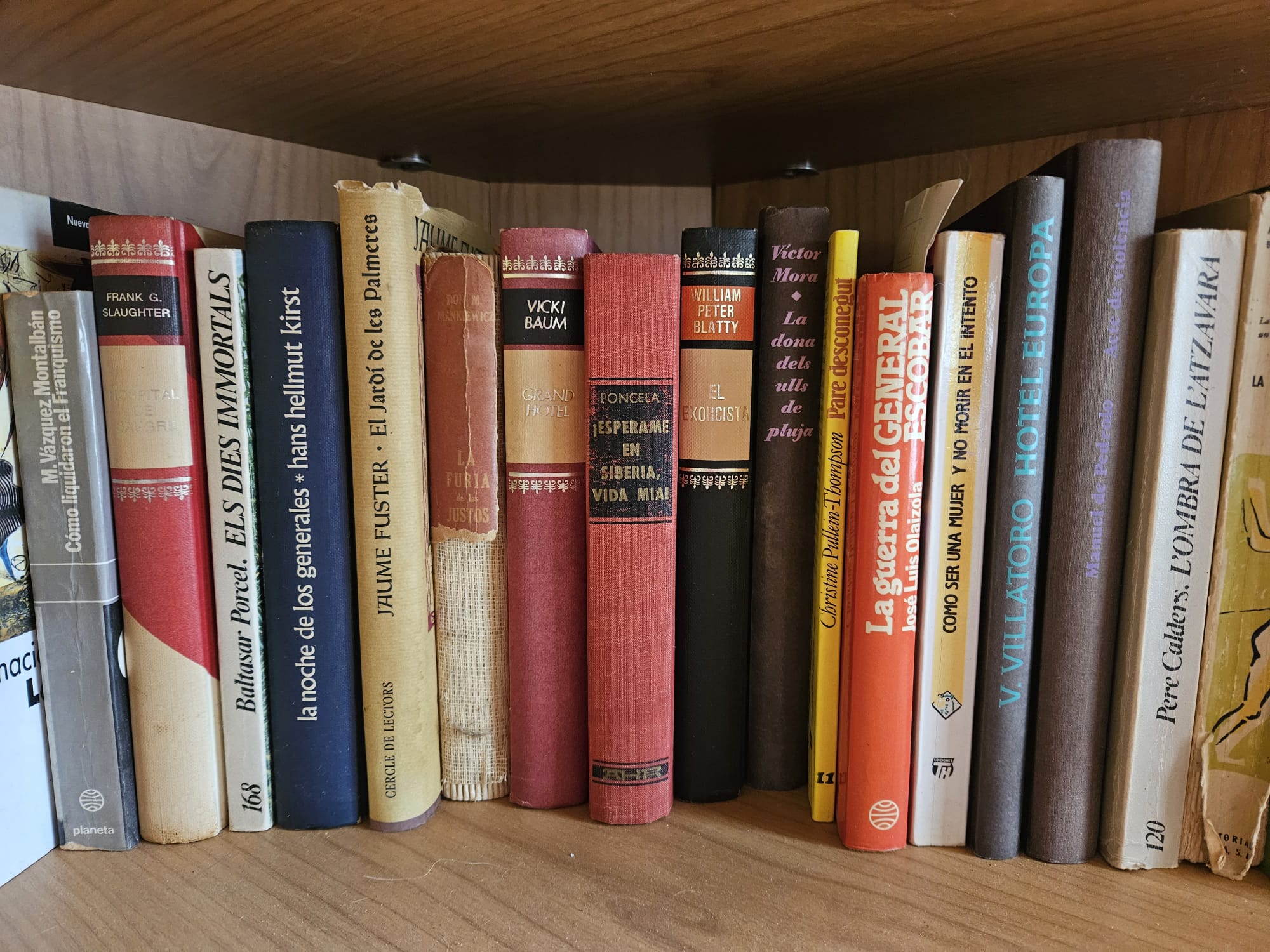
One book
“Equator” by Miguel Souza Tavares
Reading Equator (Equador) by Miguel Sousa Tavares is a great choice for several reasons, especially if you’re interested in colonial history, political intrigue, and ethical dilemmas.
The novel is set in São Tomé and Príncipe in 1905, during the height of Portuguese colonial rule. It provides a nuanced look at the political and economic struggles of the time, especially regarding the exploitation of forced labor on cocoa plantations. If you want to understand the legacy of colonialism in Africa, this book offers a powerful perspective.
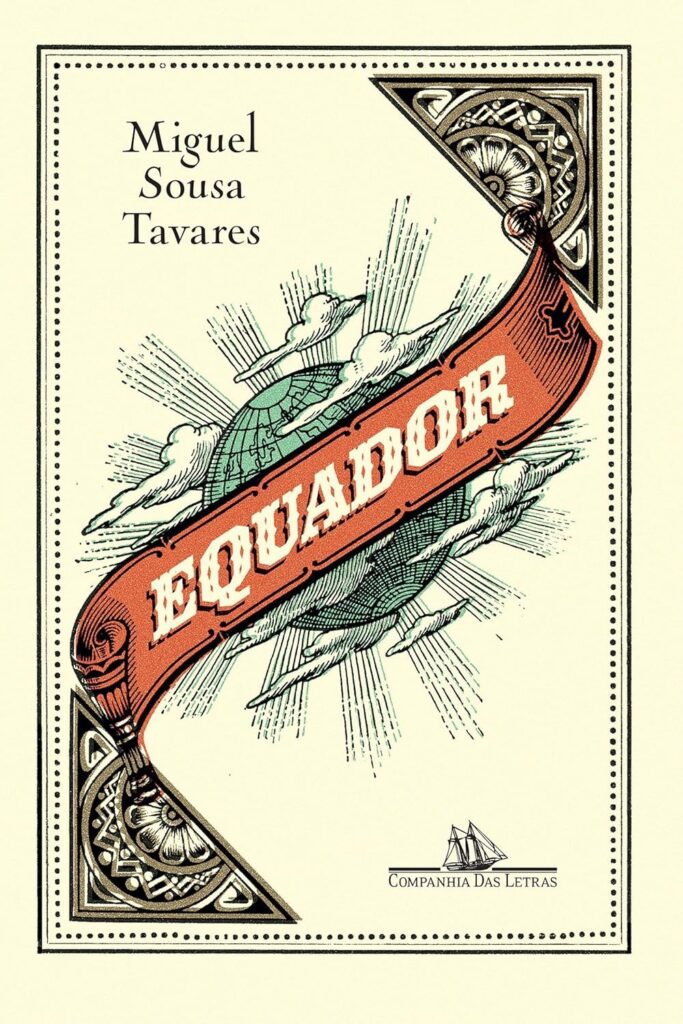
Plot Summary: At the beginning of the 20th century, Luis Bernardo Valença, a well-known Portuguese intellectual, was invited by King Carlos to undertake an unusual and complicated mission that would entail an abrupt change in his life. Single and nearly forty, he enjoyed the privileges that a large city like Lisbon had to offer. Accepting the king’s invitation meant abandoning everything for a new life, in which, however, he could put his political convictions into practice: contributing to the effective abolition of slavery in Africa by assuming the role of governor of São Tomé and Príncipe.
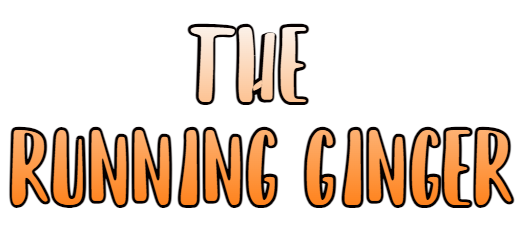

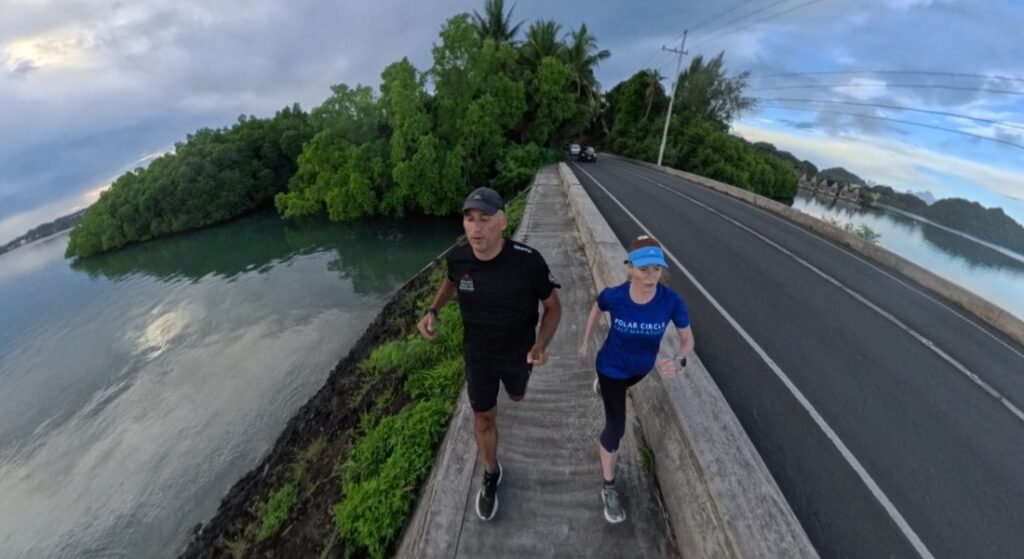

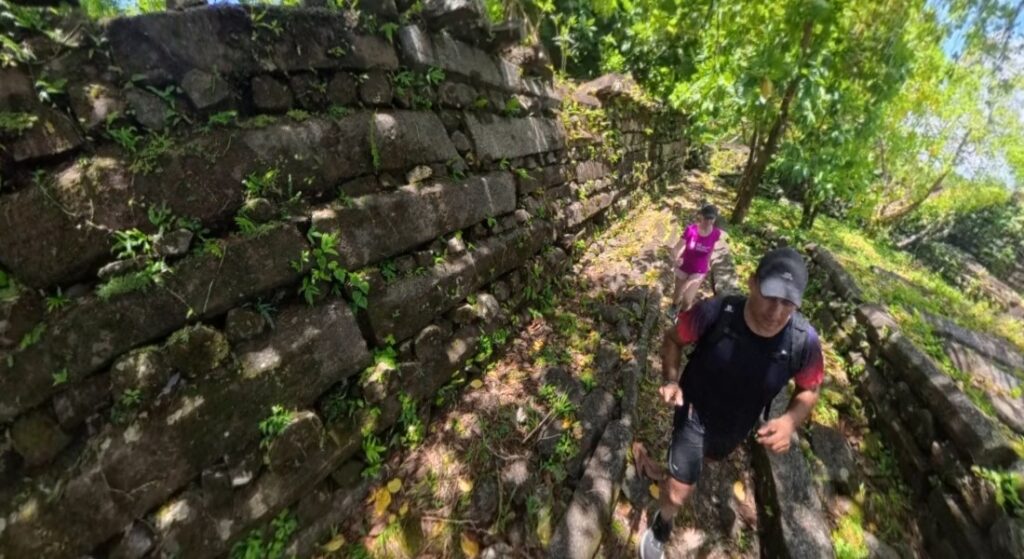
One Comment